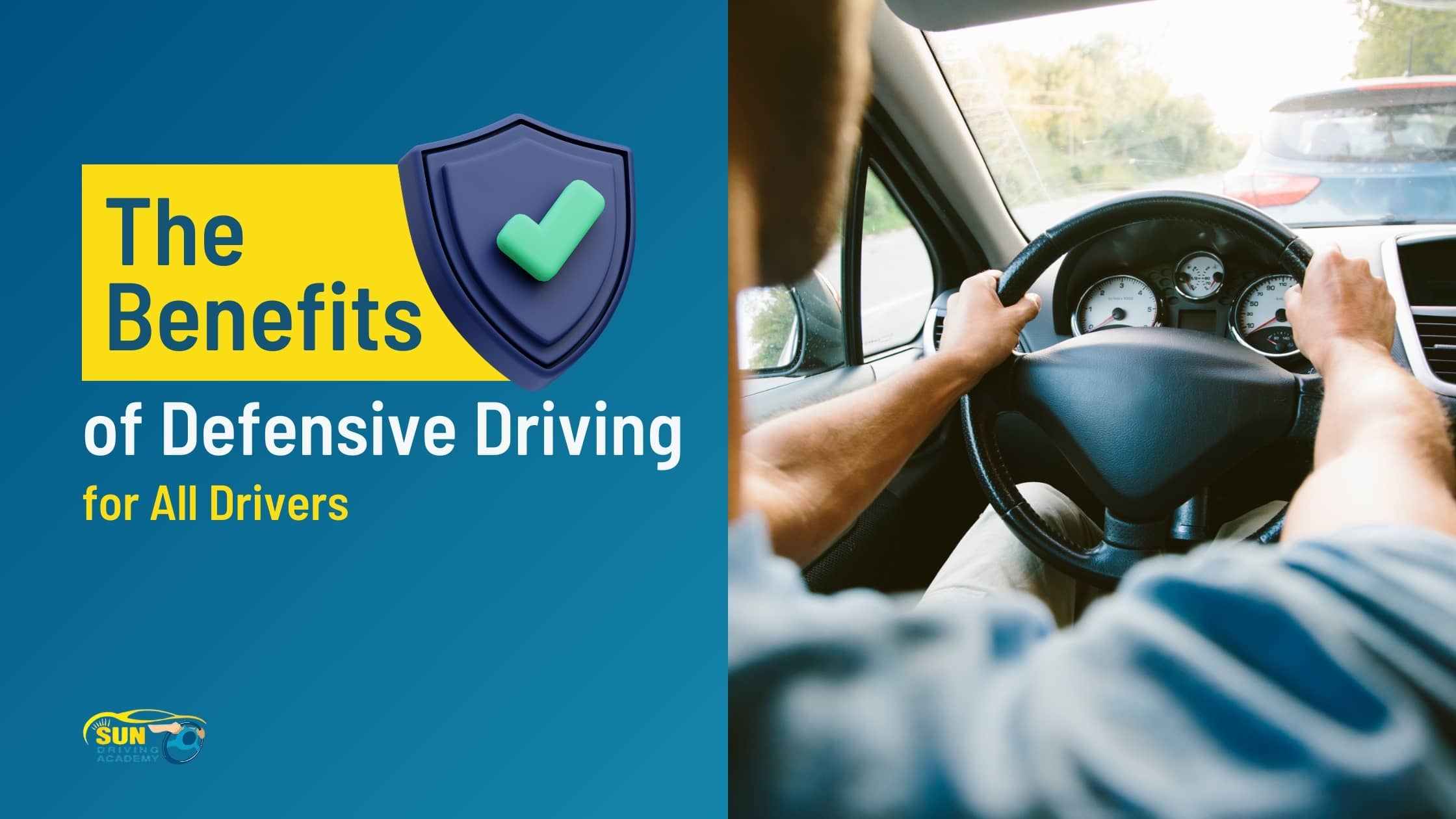Defensive driving focuses on safety, awareness, and being ready for anything while driving. By spotting possible dangers and making smart choices, defensive drivers lower the chances of accidents and create a safer environment for everyone. This article will explore the benefits of defensive driving and how it can improve your driving habits.
The Fundamentals of Defensive Driving
Defensive driving is more than obeying traffic laws; it is about having a safety-first attitude. By learning defensive driving techniques, drivers can keep themselves and others safe.
Understanding Defensive Driving Techniques
Defensive driving includes techniques to keep drivers safe and prevent accidents. These techniques involve keeping a safe distance from other cars, staying aware of your surroundings, and predicting what other drivers might do. Defensive driving helps you prepare for surprises, like sudden stops or unpredictable actions from others and teaches you to respond calmly.
Key Principles of Defensive Driving
Defensive driving focuses on essential principles like staying alert, controlling your vehicle, and being ready for surprises. These principles help drivers make quick and safe choices in risky situations. For instance, keeping a safe distance from the car ahead gives you more time to react if that driver suddenly stops.
Enhancing Road Safety
Defensive driving greatly improves road safety. Practicing it lowers the chances of accidents and helps make the roads safer.

Reducing the Risk of Accidents
Defensive driving mainly helps reduce the risk of accidents. Defensive drivers can avoid many common accidents by staying alert and watching for potential dangers. It teaches drivers to be aware of their surroundings and ready for anything.
Anticipating Hazards
Defensive drivers learn to spot dangers before they happen. This includes noticing a car that may run a red light or a pedestrian who might walk into the street without checking. By being alert, defensive drivers can take steps to prevent accidents, like slowing down or changing lanes.
Maintaining Safe Distances
Staying at a safe distance from other vehicles is essential. It gives drivers more time to react to sudden stops or changes in traffic, which helps prevent accidents. Aim to keep at least a three-second gap behind the car in front of you, and adjust this distance based on weather and road conditions.
Improving Driver Confidence
Defensive driving improves safety and increases driver confidence. When drivers feel in control and aware of their surroundings, they can better handle any situation on the road.
Building Situational Awareness
Defensive driving improves situational awareness, which is essential for confident driving. When drivers know their surroundings, they can make better choices and feel more in control. This awareness involves watching other vehicles, pedestrians, road signs, and possible obstacles.
Handling Unexpected Situations
Unexpected situations can happen anytime while driving. Defensive drivers are ready to handle these situations calmly and effectively, which helps prevent accidents. Whether facing aggressive drivers, sudden weather changes, or unexpected roadblocks, defensive driving gives you the skills to manage these challenges safely.
Legal and Financial Benefits
Defensive driving has legal and financial benefits. Driving defensively can lower insurance costs, avoid fines, and keep a clean driving record.
Lower Insurance Premiums
Insurance companies usually give lower premiums to drivers who finish defensive driving courses. They see these drivers as less likely to have accidents. Taking a defensive driving course can save you a lot on car insurance, making it a wise financial choice.
Avoiding Traffic Violations and Fines
Defensive drivers are less likely to break traffic laws, helping them avoid expensive fines and points on their records. By following traffic rules and driving safely, you can keep a clean record and avoid the costs and legal issues of violations.
Fuel Efficiency and Cost Savings
Defensive driving helps you save money on fuel and maintenance. When you drive more efficiently, you use less fuel and spend less on keeping your vehicle in good shape.

Efficient Driving Practices
Defensive driving encourages smooth driving habits, like gentle acceleration and braking. These habits can improve fuel efficiency and lower fuel costs. By avoiding sudden stops and starts, you can save money on gas and reduce wear on your vehicle.
Reducing Wear and Tear on Vehicles
Defensive drivers can save money by driving smoothly and anticipating stops and turns. This approach reduces wear and tear on their vehicles, which means fewer repairs and lower maintenance costs. It helps the car last longer and saves money on repairs and part replacements.
The Environmental Impact
Defensive driving helps the environment. When you drive more efficiently, you lower your carbon footprint and support sustainable driving habits.
Decreasing Carbon Footprint
Driving efficiently saves money and reduces carbon emissions. Using less fuel leads to fewer pollutants, which helps the environment. Defensive driving promotes eco-friendly habits that benefit drivers and the planet.
Promoting Sustainable Driving Habits
Defensive driving helps create good habits for drivers and the planet. These habits include reducing idling, keeping a steady speed, and planning routes to avoid extra driving. By following these practices, you can help the environment and support sustainability.
Defensive Driving for Different Driver Categories
Defensive driving helps all drivers, no matter their experience or the driving conditions. Whether you are a new driver, an experienced one, or a commercial driver, using defensive driving techniques can make you safer and more confident on the road.
New Drivers
Defensive driving helps new drivers gain essential skills and confidence to drive safely. It teaches them to be careful and aware of their surroundings, which is key to forming good driving habits. Taking defensive driving courses can be especially helpful for new drivers as they gain experience.
Experienced Drivers
Even experienced drivers can gain from defensive driving. It helps them keep good habits and learn new ways to handle changing traffic. By refreshing their knowledge, experienced drivers can stay current on the latest defensive driving techniques and be safe.
Commercial Drivers
Commercial drivers spend much time on the road and can benefit from defensive driving. It helps them deal with long hours and different driving conditions. Defensive driving improves safety and efficiency, reducing accidents and lower costs.
Defensive Driving Courses
A defensive driving course is a great way to learn safe driving techniques. These courses teach you how to drive safely and give practical tips to help you stay safe on the road.

Benefits of Taking a Course
Taking a defensive driving course has many benefits. It can improve your driving skills, lower your insurance rates, and help you understand road safety better. These courses give you valuable knowledge and practical tips to make you a safer driver.
What to Expect in a Defensive Driving Course
A typical defensive driving course teaches traffic laws, how to spot hazards, and safe driving habits. It includes classroom lessons and hands-on driving practice. Participants learn to keep safe from other vehicles, identify potential dangers, and react correctly in various driving situations.
Common Myths about Defensive Driving
Many myths about defensive driving need to be cleared up. Knowing the truth about defensive driving can help you see its benefits and motivate you to practice it.
Myth: Defensive Driving is Only for Beginners
Defensive driving helps drivers of all experience levels. It’s not only for beginners; experienced drivers can also learn new ways to stay safe. Defensive driving courses provide helpful tips that benefit everyone, no matter how long they drive.
Myth: Defensive Driving Means Driving Slowly
Defensive driving isn’t just about driving slowly. It means driving wisely and being aware of your surroundings. It’s about making safe choices, not just going slower. Defensive driving focuses on being proactive and ready, not just reducing speed.
Integrating Defensive Driving into Daily Routine
Make defensive driving a regular part of your routine to maintain good driving habits. This will improve your safety and the safety of others on the road.
Tips for Daily Practice
You can easily add defensive driving to your daily routine. Always wear your seatbelt, follow traffic laws, and pay attention to the road. Check your mirrors often, keep a safe distance from other cars, and stay aware of what’s around you.
Encouraging Family and Friends to Adopt Defensive Driving
Encouraging your loved ones to drive safely can improve the roads for everyone. Share what you know and your experiences with family and friends. Suggest they take a defensive driving course. Promoting safe driving in your community, you help create a safer road culture.
Defensive Driving and Technology
Technology can significantly improve defensive driving. New tools and vehicle features help drivers stay safe and aware while driving.
Modern Tools to Aid Defensive Driving
Technology can help with defensive driving. Modern tools, such as advanced driver-assistance systems (ADAS), keep drivers aware of their surroundings and help them avoid dangers. Features like lane departure warnings, automatic emergency braking, and adaptive cruise control improve your defensive driving skills.
Future of Defensive Driving with Autonomous Vehicles
As self-driving cars become more common, defensive driving will change. Future drivers must understand these changes. Even though self-driving technology aims to lower human mistakes, drivers still need to know how to safely interact with these cars on the road.
FAQs about Defensive Driving
What is Defensive Driving?
Defensive driving includes practices that help drivers reduce risks. It focuses on anticipating dangerous situations and making safe choices. This approach encourages drivers to be proactive and ready for potential hazards on the road.
How Can Defensive Driving Improve Road Safety?
Defensive driving makes roads safer by lowering the chances of accidents. It teaches drivers to be aware of their surroundings and to drive carefully. Drivers learn to stay alert, keep safe from other vehicles, and predict what other drivers might do.
Are There Financial Benefits to Defensive Driving?
Yes, there are financial benefits. Defensive drivers often pay lower insurance premiums and avoid expensive traffic fines. Also, safe driving habits can save fuel and reduce vehicle maintenance costs.
How Can I Learn Defensive Driving?
You can learn defensive driving by taking courses from driving schools, online platforms, or community groups. These courses teach safe driving techniques and practical tips for staying safe.
Is Defensive Driving Only for Certain Types of Drivers?
Defensive driving helps all drivers, no matter how experienced or what conditions they face. Whether you’re a new, experienced, or commercial driver, defensive driving techniques can make you safer and more confident on the road.
Steering Towards Safety
Defensive driving is an essential skill for every driver. It makes driving safer, lowers expenses, and encourages eco-friendly habits. When you use defensive driving techniques, you become a more confident and responsible driver, helping to make roads safer for everyone. Begin practicing defensive driving today and inspire others to do the same for a safer driving environment.




